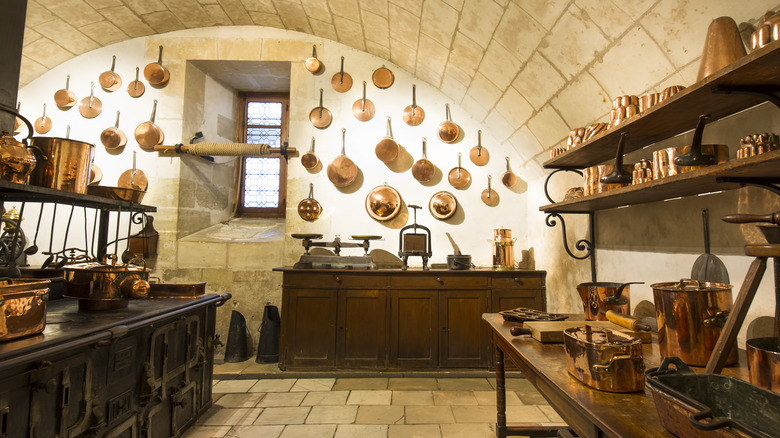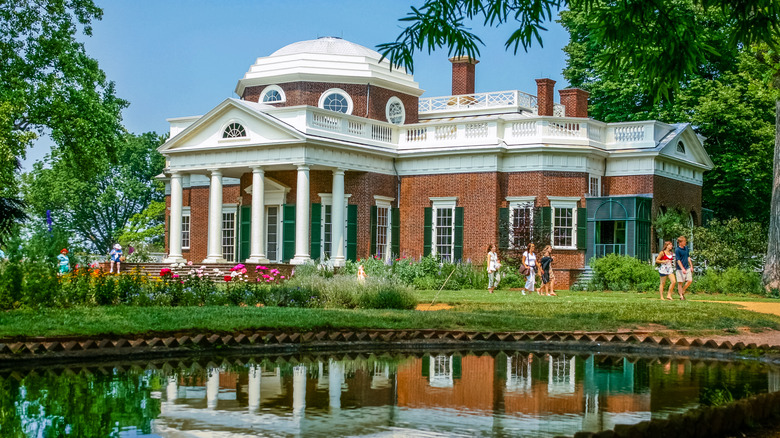The Complicated Life Of James Hemings, The First American Chef In France
Raise your hand if you were ever told Thomas Jefferson introduced macaroni and cheese to the United States. It's a tale many Americans recognize, and one that surely elevates the third president in the eyes of children who credit him with their favorite food. However, like many stories from history, this one isn't totally true. As The New York Times reveals, the first American to make this beloved dish was James Hemings. Also credited with introducing crème brûlée, meringue, and whipped cream to the states, Hemings was the first American chef to train in the culinary mecca of France (via The Virginia-Pilot); He was also enslaved by Jefferson.
The man who famously wrote, "all men are created equal" did not live true to this espousal, as Smithsonian Magazine notes that Jefferson claimed over 600 enslaved people as his property over the course of his life, with as many as 140 people held in captivity at one time at his Monticello estate. Among them was the Hemings family, which Jefferson inherited from his father-in-law John Wayles, per NPR. Wayles fathered multiple children by an enslaved woman named Elizabeth Hemings, two of whom played particularly significant, though often unacknowledged roles in American history. One was Sally Hemings, who gained recognition when a 1998 DNA test revealed that Jefferson fathered at least one, and likely all of her children (via The New York Times). The other was Sally's half-brother, James, who changed the American palate through his role as Jefferson's cook.
An American in Paris
According to NPR, James Hemings was skilled at both reading and writing from a young age, which was rare, as anti-literacy laws in some states made it illegal to teach enslaved people to read or write (via Oakland Literacy Colation). Hemmings was only 19 when he was brought by Thomas Jefferson to Paris after Jefferson was appointed America's trade minister in 1784. Jefferson wanted a personal chef trained in the art of French cuisine, so he sent Hemings to apprentice at the Château de Chantilly. The New York Times explains at the time the château's kitchen was regarded as having some of the finest chefs in France.
From there, Hemings assumed the position of head chef at Jefferson's Paris home, Hôtel de Langeac, which Monticello reports also served as the American embassy. During this period, Jefferson began to pay Hemings for his work, though Monticello notes the wage was significantly lower than that given to the previous chef. Hemings used his earnings to further his education, hiring a French tutor.
In the kitchen of the Hôtel de Langeac, Hemmings was the commander-in-chief and granted authority over the other servants, some of whom were white. It was a stark contrast to his life in the United States, but it would not last.
The return to Monticello
In 1789, Jefferson returned to the United States, bringing James and Sally Hemings (who had joined them in Paris in 1787) back with him. Under French law, the Hemingses could have sued for their freedom, but historian and Jefferson expert Annette Gordon-Reed speculates they did not want to abandon their family who had remained at Monticello (via NPR). James Hemings continued to lead Jefferson's kitchen and is assumed to have cooked at 1790's famous Dinner Table Bargain, depicted in the musical "Hamilton," according to The Baltimore Sun. In 1793, Hemings approached Jefferson and argued for his freedom. Per NPR, Jefferson agreed on the condition that Hemings train his brother Peter to replace him, a process that took three years. On February 5, 1796, Jefferson wrote a deed of manumission freeing Hemings from slavery (via the National Archives).
Far less is known of Hemings' life after emancipation. At some point, he moved to Baltimore, home to one of the largest free Black populations in the country, per the Baltimore Sun. In 1801, Jefferson, now president, found himself yearning for Hemings' food and wrote to a Baltimore innkeeper asking him to find his former chef and invite him to work in the White House. Hemings reportedly said he would only accept if Jefferson wrote to him directly, which the president failed to do.
The Sun reports that Hemings died soon after at the age of 36, evidently by suicide. Though not often recounted, Hemmings' legacy is an immortal one, preserved in every spoonful of mac and cheese or crème brûlée served in the U.S.
If you or anyone you know is having suicidal thoughts, please call the National Suicide Prevention Lifeline by dialing 988 or by calling 1-800-273-TALK (8255).


